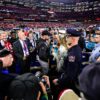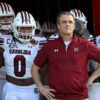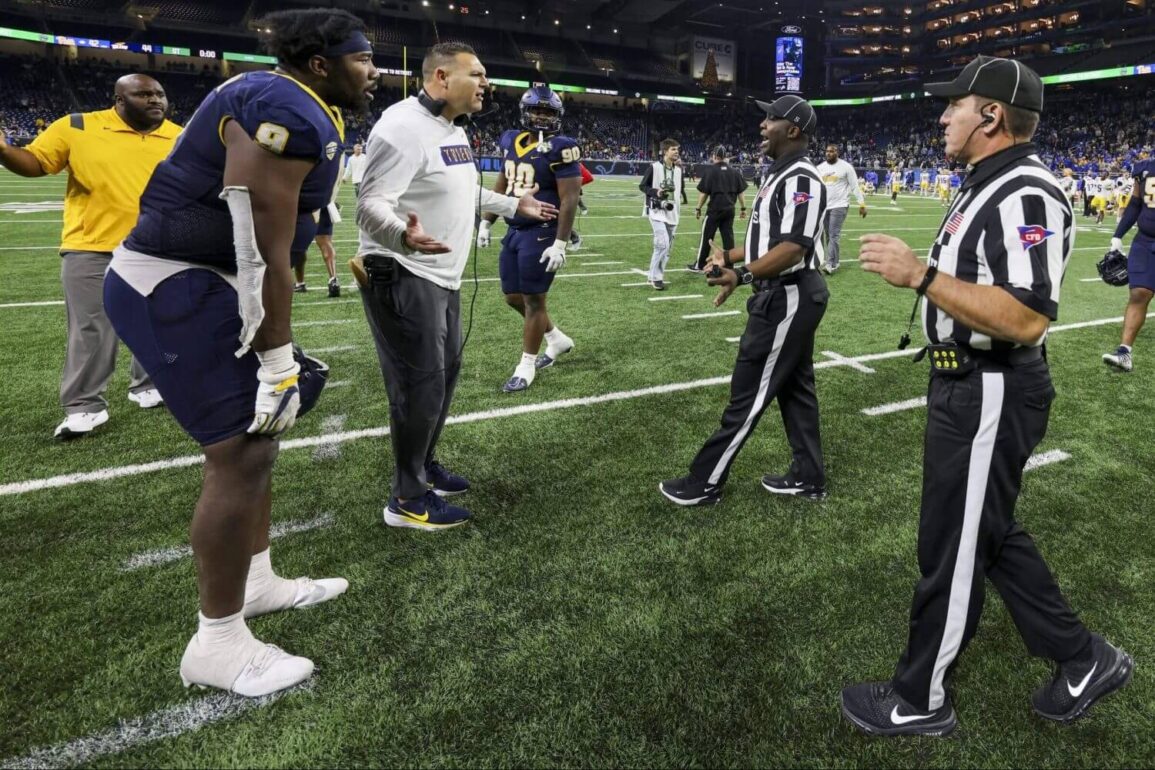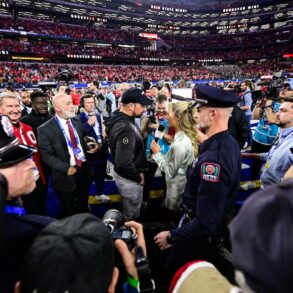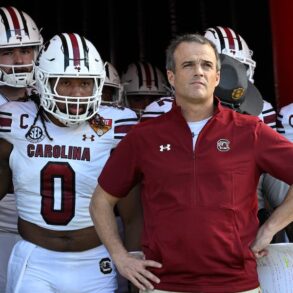Before anyone knew it was a bad call, everyone knew it was a big call.
Last October, Texas cornerback Jahdae Barron’s third-quarter interception against Georgia threatened to swing one of the biggest games of the college football season. That is, until a defensive pass interference flag thrown during his winding 37-yard return turned a roaring cheer into a smattering of boos from the home crowd, deflating a comeback. But when the home Jumbotron immediately showed the receiver had initiated the contact with Barron, the 100,000-plus in burnt orange went into a frenzy.
Advertisement
A couple of water bottles and beer cans thrown onto the field by students in the northeast corner of Darrel K. Royal Texas Memorial Stadium quickly turned into hundreds, and the game was paused. Texas coach Steve Sarkisian walked to the corner of the field and told them to knock it off.
Then, something unexpected happened.
During the stoppage, unbeknownst to everyone watching, the official who made the call told his colleagues he’d erred. As the cleanup concluded, referee Matt Loeffler turned on his mic and announced the call had been overturned and the interception would stand, a bizarre moment that several officiating experts later called “unprecedented.” Even if it was the right result, it was not a clean process to get there. It looked like fans had caused a call to be changed.
Georgia would hold on to win the game, but coach Kirby Smart said afterward, “They tried to rob us with calls in this place,” expressing worry about the precedent for fans. Georgia officials noted that SEC regulations dictate stadium videoboards cannot be used to “embarrass, humiliate, or disgrace an official or visiting team members or coaches, incite the crowd or distract a participant or coach.”
An SEC statement after the game said the evaluation and assessment of the penalty was not properly executed, but it did not specify how. In the weeks following Texas-Georgia, stoppages happened at Ohio State, Clemson and LSU due to fans throwing garbage on the field over a call.
A string of high-profile calls and reactions last season has led to a question in the sport: Is the officiating getting worse?
The Athletic spoke with more than a dozen people in charge of and around officiating about the issue. Almost all said officiating is better than it’s ever been, that the correct call percentage is somewhere around 98 percent, though some say it hasn’t improved enough or become consistent enough with technology. Coaches’ feelings are mixed.
Advertisement
But last year’s controversial plays — even those that ended up with the correct ruling — brought more attention to the issue. Officiating will never be perfect. But the amplification of social media, the expanded College Football Playoff’s stakes and the proliferation of legal sports betting have brought more negative attention to the misses than ever before.
If college football officiating is as good as those in charge say, can anything be done to convince the general public?
“Our officiating is as good as it’s ever been,” said NCAA coordinator of officials Steve Shaw. “But the game demands more than ever.”
How officiating works
Not everyone agrees with the sentiment all is well.
“It’s not getting better, let’s put it that way,” said NBC rules analyst Terry McAulay, a former NFL official and AAC officiating coordinator. “It’s stagnant at best, the actual officiating on the field. It’s just not getting better like it should be. We should be seeing more consistency both on the field and in the replay booth.”
While professional sports run their officiating from the top of the league office, college conferences staff and coordinate their officials through geographic consortiums or alliances. The Big 12 partners with the AAC, Mountain West and Southland, for example, creating its own pipeline of crews.
In 2008, the NCAA and Division I conferences formed an oversight body, College Football Officiating, to ensure officials use the same mechanics and emphases across the country. The CFO’s board, made up of 10 FBS commissioners and two FCS commissioners and run by Shaw, creates national standards for conferences to teach.
But some coaches still feel conference officials handle judgment calls differently, such as trash talk on the field.
“The SEC guys hear more s— so they don’t get worked up over dumb s—. In the Big 12, I thought I was playing a game on my kid’s church league basketball team,” said one head coach, granted anonymity to speak candidly.
Advertisement
While officials receive uniform training under the CFO, conferences still have their own grading systems. Mountain West/Conference USA coordinator Mike Defee, a former Big 12 referee, explained the system used by the Big 12, AAC, MWC and CUSA as such:
A clear, correct call is worth seven points, including the judgment and mechanics, while a correct call made in the wrong place or a marginally correct call is worth five. A missed call is worth four. An incorrect call is usually a three, but could be fewer points depending on how egregious it is. A correct no-call on a close play is a seven. There are even eights if someone does something above and beyond for the crew.
Officiating coordinators emphasized that officials who grade out poorly get fewer games or aren’t brought back at all, even if the public doesn’t have access to the full accounting. Internet sleuths noticed that the SEC officiating crew that worked Texas-Georgia was not assigned a game the following week, but the conference did not comment on whether that game’s crew had been specifically disciplined.
Officials don’t get into the industry for the money — it’s at best a side job with full-time hours that pays around $4,000 to $5,000 per game at the Power 4 level, according to people familiar with the matter. They get into it because they want to stay around football. But it takes years and years of making far less to even rise that high, spending time and money on numerous offseason clinics and practices. ACC coordinator of officials Al Riveron said it generally takes at least 10 years of officiating to reach the Power 4 conferences.
“If you really want to stay in this business long enough, and you want to be real good at it, it’s a full-time job-and-a-half,” Riveron said.
During the season, officials spend dozens of hours between travel, the game itself, film review and meetings. By the time they’re on a flight home after a game, the TV broadcast is typically loaded onto an iPad for them. By Sunday, various angles of coach film are there, too. Before Tuesday, officials will rewatch up to 200 plays in a game between both teams, sometimes multiple times, and the grades come in.
They must pass a physical fitness test every year, and each June, they’re given a 100-question quiz by the CFO and must score at least an 85 to be eligible for the season.
Advertisement
Another coach who has spent time in college and the NFL said he noticed a difference between the two, and also between college conferences. The NFL often pulls up the best college officials for its own use, too.
“They’re definitely more knowledgeable and more helpful in the (NFL),” the second coach said. “NFL officials are a lot more personable.”
While each conference says its officials make the correct call most of the time, they know a big mistake in a key moment can outweigh a correct call on a simple play. Fans and coaches only remember the bad calls, and last season had its standout moments like every other.
Mistakes and transparency
In September, the Sun Belt admitted its replay official got a call wrong on a game-winning touchdown catch by Arkansas State against Central Arkansas with three seconds left, when video showed the Red Wolves receiver clearly losing the ball as he hit the ground. But the league declined to comment on any punishment for the official.
Conferences generally keep punishments private these days, but that didn’t used to be the case.
In 2009, then-SEC commissioner Mike Slive publicly suspended a crew that had made an incorrect personal foul or unsportsmanlike conduct penalty in two separate games. Meanwhile, leagues like the NBA are moving toward increased transparency, with public reports assessing the calls made in the last two minutes of a game. NBA fans know the names and call histories of officials. And although several college refs are famous and infamous within certain fan bases and leagues, college leaders are worried about backlash toward officials going any further.
“If we start publicly pounding officials,” Shaw said, “a lot of bad things happen with that.”
John McDaid, who has overseen the SEC and Sun Belt officials for five years, said the SEC has issued three statements in his five seasons as coordinator, including when an error caused Penn State to lose a down in its 2021 win over Auburn.
Advertisement
“Our policy is that we’re not going to put statements out on something that’s just purely judgment-related,” he said. “So, (only) if we have a misapplication of a rule or some other unusual circumstance that doesn’t necessarily have to do with judgment.”
In January’s Peach Bowl between Texas and Arizona State, a late targeting review was upheld as a non-call by a Big Ten crew. There was no question or answer about the decision afterward because no reporter at the game asked about it, despite a pool reporter policy in place that is not typically available in the regular season. The CFP later told The Athletic the proper process was followed, but Big 12 commissioner Brett Yormark called for a re-evaluation of CFP officiating after the Sun Devils’ loss.
Would it help to let fans in on that process?
The United Football League, the spring pro league on ESPN and Fox, televises live audio and video of officials talking with coaches on the field and during the instant replay process, rather than having the play-by-play booth refer to a rules expert for their explanation. UFL VP of officiating Dean Blandino, a former NFL official who serves in that rules expert role for Fox’s college football broadcasts, started doing this in 2020 with the XFL, talking through live decisions from the replay booth. He said the feedback has been nothing but positive.
“There’s no secrets,” Blandino said. “This is what we saw. You come away with a greater understanding of what goes into it. Sometimes fans watch a game and have no idea, and you go to (conspiratorial) reasons. If you just can see and listen to it, it eliminates the concern that something else is going on and people are doing the best they can.”
After review, pass interference was called on the Defenders.
Take a listen into the replay booth ⬇️ pic.twitter.com/hJNyVm9pmM
— United Football League (@TheUFL) April 6, 2025
Some conferences have adapted, showing the replay feed the official is watching on the stadium videoboard, but some in the officiating community want more. The ACC late last season began letting the broadcast’s rules analyst listen in on the replay conversation and relay to viewers what went into a decision in some games.
“I think that’s a wonderful model,” Defee said. “One of the biggest things that hurts us are TV and the broadcasters who have no idea (of the criteria for a review).”
Advertisement
It might’ve thwarted the Pac-12’s replay scandal in 2018, when league general counsel Woody Dixon, who was not a trained official, reportedly overruled a targeting decision by the officials in the replay command center. One officiating coordinator said that situation set the perception of the officiating community back years.
The ACC plans to use more of its system next season. It could’ve helped in last September’s Virginia Tech-Miami game, when Virginia Tech seemed to complete a game-winning Hail Mary on the final play.
Following an extended pause with no call either way, officials ruled it a Hokies touchdown. Then, following a long review, it was ruled incomplete without an on-air explanation. After the game, the ACC released a statement explaining that a Miami player who was out of bounds touched the ball, ending the play. But that wasn’t made clear during the broadcast. In the moment, some fans wondered whether the ACC preferred Miami to win. Again, the consensus was that the right call came as the result of a shaky-at-best process.
The full UFL replay model would be harder to execute in college football, with multiple games going on at once. And one conference administrator questioned how effective the spring league’s transparency system would be in the college game, with more diehard fans invested and poised to scrutinize every aspect of the conversation.
In fact, college football’s transparency is going in the other direction. This upcoming season, replay reviews that don’t change the officials’ decision will no longer be announced as either “the call is confirmed” or “the call stands,” indicating how clear the evidence was. Instead, the call will only be described as “upheld.”
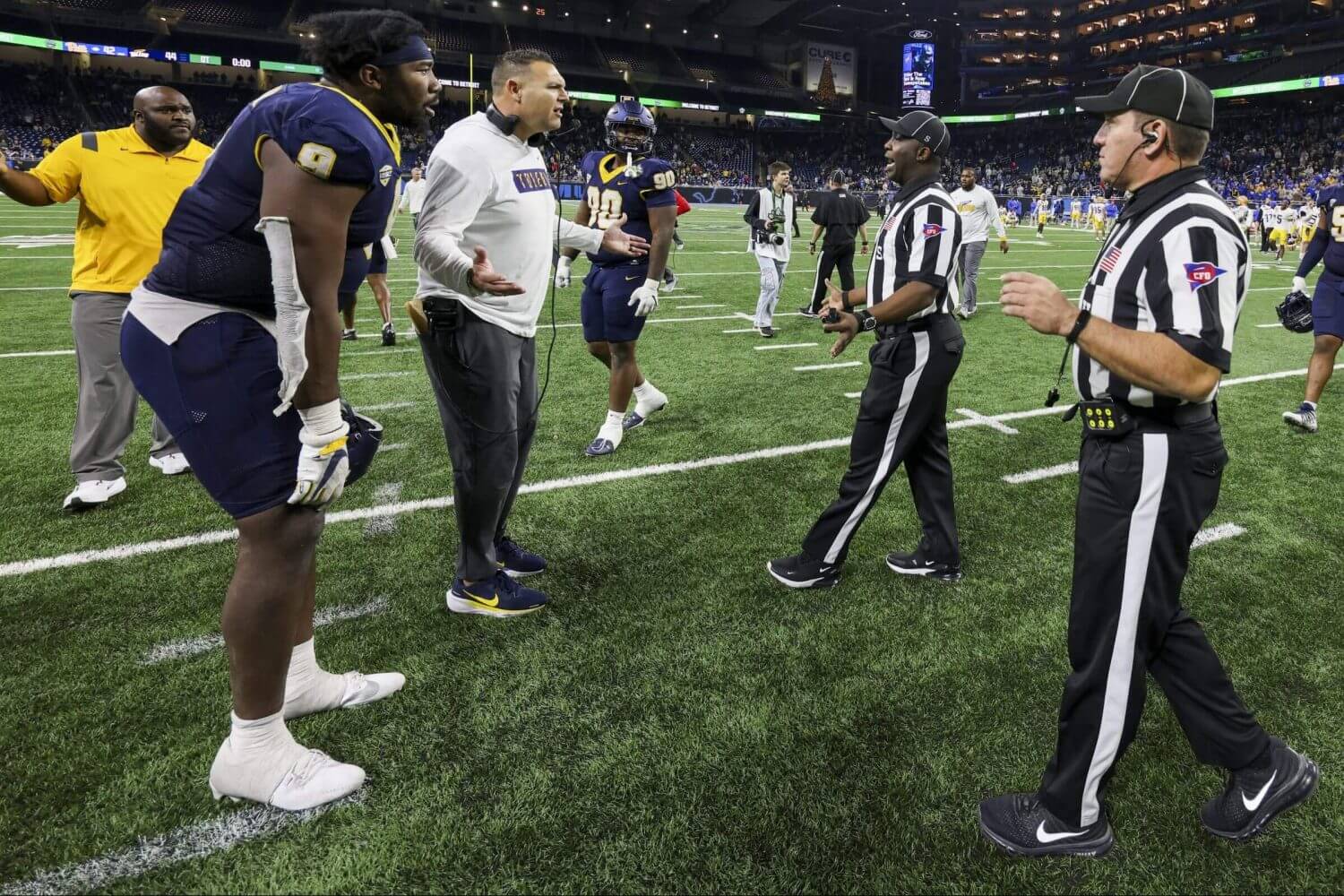
Coaches and staffers appear quicker to go public with demands for answers as the stakes rise on every officiating decision. (Mike Mulholland / Getty Images)
Technology
Each Power 4 conference has a replay command center for consistent rulings, and that technology is a key reason officials say they’re better than ever. But some in the community believe the knowledge that replay can fix their split-second decisions has become an unhealthy crutch for officials.
“It’s created some hesitancy,” said Fox Sports rules analyst Mike Pereira, a former NFL and college official. “It’s created a look to the game which is concerning to me with stops. … As much as I was a proponent for it in the NFL in 1999, I didn’t anticipate how the monster would grow.”
Advertisement
The college football rules committee has discussed moving to a challenge model like the NFL, rather than leaving all reviews up to the officials. But coaches have generally been against the idea, because it would move the burden to them and could cause some incorrect calls to go through.
“It was never designed to be a get-everything-right system,” Blandino said. “We’ve migrated so far away from that.”
But technology is making it harder to avoid the quest for perfection. The NFL this year will use Sony’s Hawk-Eye camera technology to measure first downs and keep the traditional “chain gang” as a backup option. Hawk-Eye played a key role in confirming the Denver Nuggets’ buzzer-beating dunk against the Los Angeles Clippers in the NBA playoffs. The USFL precursor to the UFL used tech to measure a ball spot like a tennis line call.
“I think replay has taken the art out of officiating,” Pereira said. “They’ve made it a science. The best officials ever knew what to call, when to call it and what decision needed to be made by how it looked. But now we’re into this where we’ve got to get everything perfect, it’s just different.”
How much replay is too much? College basketball has dealt with the same question. Earlier this month, men’s and women’s basketball added a coaches challenge and removed automatic replays for out-of-bounds calls in the final two minutes for the sake of game flow. College football rule makers have tried to expedite game flow in other ways, including tweaking the clock rules. The targeting rule has decreased headshots since it was introduced in 2008, but it has added stoppages, and the perceived inconsistency of those calls has frustrated fans and coaches alike.
Conference vs. national officiating
Why do conferences have their own officials in the first place? It’s just how it’s always been. But as the stakes of the games rise in the 12-team CFP era, the conspiracy theories only get louder.
McAulay brought up the eight-overtime Georgia Tech-Georgia game last Thanksgiving weekend in which the Bulldogs were fighting for a CFP berth. An SEC crew officiated the game, which included several controversial calls.
Advertisement
“These conference labels are just archaic,” said McAulay “These little fiefdoms the conferences have maintained about their officials, it leads to a valid perception that, well, there’s a lot of money at stake if Georgia loses.”
But the sheer number of games across the country in a given week make it impractical for officiating crews to flow up to one national organization. Last season McDaid oversaw 17 crews — the same number employed by the NFL — between the SEC and Sun Belt alone.
“Every week, every game, every play, we’re evaluating what’s going on across 11 (on-field and replay) positions,” he said. “If we did that nationally — how could you do that?”
Men’s and women’s basketball also use a regional/conference model during the regular season. Come postseason, however, a national coordinator makes the assignments, ensuring the best officials in the country work the NCAA Tournament. Football has not followed suit. Yet.
The conference commissioners who run the CFP have discussed using a “blended” crew of the best officials from across their leagues for the semifinals and the national championship, similar to the NFL playoffs.
In the current setup for the 12-team CFP, the top two crews from each Power 4 conference are assigned to the eight first- and second-round games, working games that don’t involve their conference. Those crews are evaluated by Shaw, and the best that don’t conflict with participating teams work the semifinals and championship game.
A shift to blended crews is likely still years away and may need to be tested in non-CFP bowl games, first. But it could help remove the perception of conference interference.
“I think there’s confusion,” ACC commissioner Jim Phillips said. “People look at where the officials come from. They’re CFP games, not ACC games or Big Ten games. We haven’t done anything to rectify that, and that’s what is difficult, what we saw last year and people attaching that to a certain conference.”
Advertisement
Safety and abuse
Officials, coaches and administrators agree that technology and social media have made life harder for officials. All those camera angles that get a call right also highlight when a call was wrong.
“I used to sit in the office and think, ‘God, we missed that one, but nobody will ever see it,’” Pereira said. “Now, you miss something and it’s on social media in five minutes.”
Conferences provide stadium security for officials, and Shaw said it’s as good as it can be. But there’s only so much security can do.
“You used to be a nameless person that worked the game,” Shaw said. “Now people online know your family’s names, where you live. We worry about that a lot.”
That dynamic leads to concerns about the pipeline of future officials. A shortage of officials is forcing postponements at the high school and lower levels. The Dallas Football Officials Association told The Athletic in 2019 it’s considered a success if three out of every 10 new high school officials return for a second season.
AAC back judge and UFL official Michael Kennedy said abuse toward officials is much worse at the youth and high school levels, with players’ parents the main offenders. Kennedy, who spent 20 years in the Navy, recounted officiating a youth basketball game where a parent posted about Kennedy on Instagram afterward and tagged Kennedy’s 14-year-old son.
“The way social media ignites negativity, it’s very dangerous,” he said.
College football and the NFL need those new officials to make it up through the pipeline. Kennedy participates in Battlefields to Ballfields, an organization started by Pereira to get military veterans into officiating. They’re used to handling stressful situations, after all.
“I have friends working in college that have told me there were certain points where they considered hanging it up, that it’s not worth it,” Kennedy said. “But they have a good support system.”
Can expectation meet reality?
In February, across the world in Turkey, a Slovenian referee had to be flown in to officiate a soccer match between two of Turkey’s biggest clubs. Conspiracies around domestic officials from fans and teams had boiled over into physical attacks and threats to abandon games and leagues.
Sports officials have been the target of jokes and ire from fans for as long as sports have existed. Shaw joked that nobody dreams of becoming an official. Criticism comes with the territory.
Advertisement
What worries those in college football is the criticism trending louder and more conspiratorial, including from those in leadership positions. In November, Utah athletic director Mark Harlan was fined a Big 12-record $40,000 for saying in a postgame press conference that a Utes game was stolen, after a fourth-down penalty kept BYU’s game-winning drive alive.
That’s not as bad as Turkish soccer, but concerns over conference favoritism and legalized gambling incentives from fans are only increasing. They help a bad call linger much longer.
“Our society today is so polarized and amplified,” Shaw said. “Everything is over the top. The polarization of the teams, conference, everything, has never been higher.”
Football will always have its bang-bang plays and debatable calls, and humans will always make mistakes. It’s the egregious mistakes that aren’t supposed to happen. And with so much on the line with every call, the pressure on everyone involved is only growing.
“It’s a never-ending journey for perfection,” Defee said. “We’re making progress, but I don’t know it’s a journey we’ll ever see to its end.”
— The Athletic’s Stewart Mandel and Bruce Feldman contributed reporting.
(Top photo: Christian Petersen / Getty Images)
This post was originally published on this site be sure to check out more of their content.


